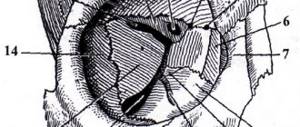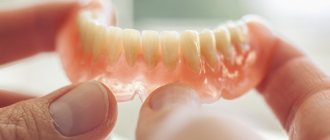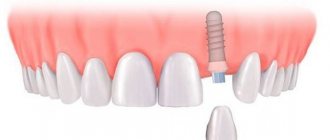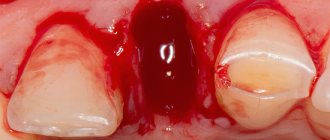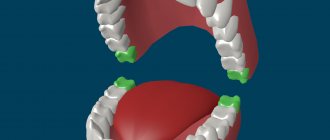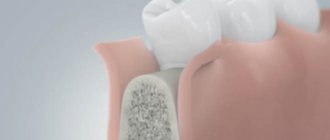Indications and contraindications for installing implants in the upper jaw
Main indications:
- partial or complete edentia;
- aesthetic defects resulting from the destruction of crowns.
Contraindications are conditional (include health problems for which the procedure is prohibited, implantation is possible after their exclusion) and absolute (implantation is contraindicated).
Diseases of the heart and blood vessels are one of the absolute contraindications to surgery.
Absolute contraindications:
- chronic teeth grinding;
- increased tone of the masticatory muscles;
- blood clotting disorder;
- diseases of the central nervous system;
- pathologies of the heart and blood vessels;
- dysfunction of the endocrine system.
Relative contraindications:
- inflammatory processes of the oral cavity;
- thinning of the bone structures of the jaw;
- pregnancy and breastfeeding period.
How to reduce the risk of rejection:
- Provide the doctor with reliable information about the patient’s health status;
- Provide timely and high-quality oral care;
- Carry out follow-up visits to the doctor at the appointed time;
- When the first unpleasant symptoms appear, immediately contact a specialist;
- Include fish, broccoli and dairy products in your daily diet;
- Exclude from the menu foods that can damage implants (solid foods) and reduce the amount of sweets as much as possible.
The female body has its own characteristics - changing hormonal levels, pregnancy and menopause affect the survival rate of implants. Therefore, it is important to work through each feature at the treatment planning stage. The doctor must be aware of all the nuances of the patient’s body so that the chosen treatment tactics ensure the effectiveness of the event.
Implantation should not be performed if a woman is menstruating or during pregnancy.
During menopause, additional examination is required, since metabolic processes in the body are disrupted.
To get the answer to this question, you should visit a dentist. The doctor will determine whether there are signs of unwanted effects and take appropriate measures to prevent rejection.
Signs that the dental implant has not taken root:
- Swelling of the mucous membrane, which does not decrease for more than a week after surgery;
- Bleeding longer than two days after implantation;
- Pain that lasts longer than a week;
- Fever for more than three days;
- Purulent discharge and unpleasant odor;
- Implant mobility.
What are the complications of implantation in the upper jaw?
The procedure for implanting upper teeth is more difficult than lower teeth due to the softer structure of the maxillary bone. Restoration of lost units from above is carried out with elongated models of titanium roots:
- in areas near the maxillary sinus;
- into pre-grown bone mass;
- after a sinus lift (increasing the volume of lost bone by raising the maxillary sinus and filling the resulting space with biomaterial).
Implantation in the lower jaw is carried out with the expectation of eliminating damage to the trigeminal nerve . To do this, a computed tomography scan is first performed, which allows you to accurately determine its passage. If there is insufficient bone volume, it is also restored using bone grafting.
The requirements for the aesthetics of the upper dentition are excessive, because when you smile, the upper jaw is visualized more
Types of Dental Implants
Every person understands that modern dentistry has made a huge breakthrough. And even a completely toothless person can become the owner of a dazzling, snow-white smile. Some people want to quickly slip out of the dentist's chair, so they prefer procedures that are carried out in one stage.
With such implantation, a titanium base is immediately implanted and an abutment is installed. For about six months, the doctor installs temporary prostheses, which, after complete engraftment, are replaced with permanent ones.
Most specialized doctors advise choosing an implantation procedure that takes place in two stages. First, the base is implanted and the gum is sutured. After complete healing, the second stage begins. After the abutments are installed, the gum tissue must be sutured again.
Of course, this technique is quite painstaking and requires long healing, but this is what doctors give the greatest preference to.
Features of implants for chewing and anterior teeth
Implantation of chewing teeth is carried out taking into account the increased chewing load on them. The artificial root is selected individually. However, when restoring lateral units, it should not be short and thin.
Implants are produced:
- lamellar (used in case of bone atrophy);
- root-shaped (implanted into bone tissue of sufficient volume);
- combined.
According to the type of construction for molars, the most reliable titanium rods are of the following types:
- endosseous (intraosseous);
- subperiosteal (implanted into the alveolar process);
- intramucosal (part of a removable denture);
- endodontically stabilized (extend the root system by 7 and 8 units).
Implantation of frontal units involves focusing on the aesthetic result, since the incisors are practically not involved in the chewing process. Therefore, the strength requirements for implants are not so high. They are selected taking into account the following characteristics:
- Maximum biocompatibility of the material with jaw structures.
- The length should be within 10 mm.
- Small diameter. This indicator ensures the implantation of the rod with minimal damage to nearby tissues, which is also significant for the aesthetic result.
In the photo from left to right: endosseous and subperiosteal type of implant designs
Classic – dental implantation in 2 stages
The classic method has long been time-tested, but it has its own nuances - both pros and cons. In this case, the entire treatment process can be divided into two stages: first, implants are implanted, and only after 2-6 months can the doctor fix the prosthetic device - this is the time required until the root replacements are completely implanted. The key advantages of this method include the ability to form a beautiful and smooth gingival margin, as in the photo below. This is a very important condition for teeth falling into the smile zone. Most often, this concept is used to fill scattered “voids” in the dentition. If there is a need to restore from 1 to 4 lower front teeth, then this is the best option.
Classic two-stage dental implantation method
As for the disadvantages, the main disadvantage of this method of treatment is its duration. In addition to the fact that the patient will have to wait for complete osseointegration of the implants, it is likely that several months will be required for the restoration of bone tissue volumes. The thing is that this protocol is extremely demanding on the condition of the bone. Since atrophy develops very quickly in the absence of teeth, at the time of contacting a specialist, with a 99% probability the patient has a clear lack of bone tissue for reliable attachment of titanium rods. Additionally, it is necessary to carry out the procedure of its extension, which is very expensive both in time and money.
Options for setting teeth up
Implantation of the upper dental row is carried out in two ways - one-stage and two-stage. Recently, dentists are more often choosing the first technique due to the immediate aesthetic result, especially when restoring anterior units. However, the express method is more risky in terms of tissue infection and has a greater number of contraindications compared to the classical one.
Classic technique with delayed loading
The two-stage implantation method includes:
- Implantation of an artificial root into the gum.
- Fixation of the crown after 2-5 months.
Before the procedure, the patient undergoes:
Orthopantomogram of the maxillofacial apparatus
- sanitation of the oral cavity for inflammation;
- general examination to identify contraindications;
- consultation with an otorhinolaryngologist (for restoration of teeth in the upper jaw);
- X-ray examination of the maxillofacial apparatus and orthopantomogram.
Next comes the most important moment - the implantation of a titanium rod. The operation is performed under local anesthesia in the following sequence:
- An incision in the gum and detachment of the mucous membrane.
- Preparing a place in the bone for the implant by drilling.
- Threading (unless it is a model with self-tapping threads).
- Screwing in the titanium root.
- Stitching.
Once the healing process is complete, an abutment is attached to the implant and a crown is placed.
The duration of the process of osseointegration of the rod with tissues ranges from two to five months.
One-step installation with immediate loading
It is carried out quickly with an immediate load on the artificial root. Often used after tooth extraction. The specialist’s action plan is as follows:
- Introduction of anesthesia.
- Unit extraction.
- Preparing the bed for the implant.
- Installation of the rod.
- Installation of a temporary crown.
After the end of the osseointegration period, the temporary crown is removed and a permanent one is placed.
What to do to prevent complications
You can avoid complications after the process of osseointegration of the artificial root with the jaw tissue is completed by adhering to simple rules:
- Have your teeth professionally cleaned at the clinic twice a year. The procedure is performed using ultrasound and provides high-quality results. At the end of the process, the specialist applies special pastes and varnishes with a polishing effect to the teeth.
- Use a toothbrush and toothpaste that must be selected in accordance with the dentist’s recommendations.
- Use dental floss regularly. It effectively helps to get rid of food debris in the interdental spaces.
- When performing hygiene procedures, pay attention to the tongue and the inside of the cheeks. They also need to be cleaned with the back of a toothbrush.
- Use mouthwash. It kills pathogenic bacteria and freshens breath.
For a successful osseointegration process, it is necessary to adhere to the dentist’s recommendations and maintain careful oral hygiene.
Why is it necessary to build up bone tissue and do a sinus lift?
Often with edentia there is a lack of bone mass. The longer the space in the jaw is empty without proper load, the more active the atrophic processes are. Volume can be restored through bone grafting. This is an effective procedure aimed at creating a reliable foundation for a titanium rod. It is indicated for:
- bone atrophy;
- loss of tissue due to periodontitis (inflammatory process of the structures that support the tooth);
- deterioration of bone condition after injury.
More often the problem occurs in the upper jaw. This is due to the peculiarities of the anatomical structure. A significant part of the bone in the upper row is the maxillary sinus. The sinus lift technique allows you to restore the missing volume. The procedure is carried out if:
- bone structures have decreased in the area of the alveolar process;
- there is a loss of thickness due to the anatomy of the jaw.
How many implants can and should be placed with complete edentia?
Implantation of the maximum number of units
The technique involves implanting an implant in place of each missing tooth (14 titanium roots on top and bottom). Then a crown is placed on each one. Only the eights, and sometimes the second molars, are excluded from the restoration process. In the latter case, 12 rods are installed. Implementation of the technology in conditions of complete edentia is possible only if the required volume of bone mass is available.
When an inserted prosthesis is attached to a minimum number of supports
If it is impossible to implant at least four implants, implantation is carried out on two or three units. Due to the subsequent attachment of abutments with a spherical tip, the prosthesis can be removed during hygiene procedures.
The second method of fixation is beam , which ensures correct distribution of the load during chewing of food and is slightly superior in reliability to spherical. An orthopedic structure secured in this way is also easily removable.
The prosthesis for spherical fastening in the design has rounded cavities corresponding to the outline of the abutments, and with beam fastening, the opposite part has the appearance of a dissected pipe.
Installation of a bridge on 4 or 6 artificial roots
All-on-4 ” and “ All-on-6 dental implant concepts are the best solution to the problems of complete edentia. They are used for:
- bone atrophy;
- close location of the maxillary sinus and the mandibular nerve.
Implantation with four or six implants
The technology involves the implantation of four or six implants from above and below. The first ones are placed in place of the frontal units, the rest - at a certain interval. The latter are screwed into the jaws at an angle of 45⁰. The final stage is the installation of a removable or non-removable structure.
How much will it cost on average in Moscow?
The cost of implantation in different clinics is determined individually, taking into account:
- volume of planned work;
- materials used, medications;
- diagnostic procedures;
- the patient's wishes regarding aesthetics.
Let's give the average cost of dental implantation services in Moscow clinics.
| Name of service | Cost, rub. |
| Temporary crown | 4000 |
| Installation of the healing abutment | 5000 |
| Custom abutment | 7500 |
| Implantation, without implant cost | 22000 |
| Removable denture locator | 25000 |
| Turnkey implantation of one tooth using a two-stage method | |
| With metal-ceramic crown | 39100 |
| With all-ceramic crown | 50200 |
| Express implantation with metal-ceramic crown | 58000 |
| With a ceramic crown on a special alloy | 60000 |
| Full dental implantation for edentulous jaws | |
| Prosthetics on 4 implants according to the “All-on-4” protocol | 350000 |
| Prosthetics on 6 implants according to the “All-on-6” protocol | 450000 |
| Installation of 14 implants on the jaw, with bone grafting and prosthetics | 900000 |
